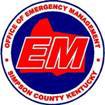|
Good morning Simpson County residents. I am Robert Palmer. Director of the Simpson County Office of Emergency Management here with my February Preparedness message to discuss earthquakes
To prepare for an earthquake we continue to encourage the development of a disaster kit. This kit should have items you must have available for your survival and comfort after any disaster has struck. Main items will include medications, water, non-perishable food, cash, battery operated radio for news reports, clothing and a communications plan. Each person in a home should have their own kit and it should be located where it can be accessed in a hurry as your family evacuates. For assistance in disaster kit development you may contact our office. An earthquake is the sudden, quick shaking of the earth. It is caused by rock breaking and moving under the ground. Additional earthquakes, known as aftershocks, can occur for hours, days, or even months after an earthquake. These are usually smaller than the first earthquake. However, they could cause more damage to structures weakened by the first earthquake. So how should we respond to an earthquake? If you are outside, STAY THERE!! Move away from buildings, streetlights and wires and remain there until shaking stops. Be very cautious before reentry to any building ensuring it is safe to do so. If you are inside, remember to DROP, COVER and HOLD ON. Pretty easy huh? DROP to the ground, COVER your head and neck with your arms, a pillow, a book or whatever is available. Then HOLD ON and maintain your position with your head and neck covered until the shaking stops. That is all the time I have for this month’s message. I want to remind you that at noon today we will activate the community outdoor warning sirens to test and exercise them as we do each month. If the siren in your neighborhood does not activate, please call my office at 270 586 1800 and report it. My next preparedness message will be on March 2nd. Thank you and please have a safe month! Resources: https://www.ready.gov/earthquakes
0 Comments
Winter Weather Safety Tips
Everyone is potentially at risk during winter storms. Most fatalities are indirectly related to the storm. People die from traffic accidents on icy roads, heart attacks while shoveling snow, and hypothermia from prolonged exposure to cold and unsafe residential conditions. Be prepared for winter weather! Listen to NOAA weather radio or commercial radio/television to stay informed about winter storm watches, warnings and advisories. At home and work, plan ahead for winter storms by having these on hand:
Before starting out in a vehicle:
Dress for the storm if you must be outdoors during severe winter weather:
If you are caught outdoors during hazardous winter weather:
1/7/18
Good morning Simpson County residents and Happy New Year. This is Robert Palmer from the Simpson County Office of Emergency Management with my monthly preparedness message. Today at noon we will activate the Community Outdoor Warning Sirens for our monthly test. If one does not activate, please report it to our office. Today’s preparedness message will be about Winter Weather Safety. Everyone, but especially the elderly and very young, are potentially at risk during Cold, winter weather. This is even more critical during winter storm events. The interesting statistics are that most winter fatalities are actually indirectly related to a storm. Most of the activities that cause people to be killed are: Traffic accidents on icy roads. Heart attacks while shoveling snow. And, hypothermia from prolonged exposure to cold or while living in unsafe residential conditions are more causes of death from winter time weather. So whether you are at work, at home or traveling, here are just a few items to have on hand for your safety and comfort. Always have a flashlight with extra batteries available wherever you are. At home and at work a battery backed up NOAA weather radio, and non-perishable food and water, including a can opener are staples to becoming prepared. Having an alternative heat source for comfort as well as for cooking is good to have, but for safety sake, please remember to be sure it is properly vented and ALWAYS keep flammable materials such as fuel and clothes at least three feet away from it. And, if it is portable, keep it at least three feet away from walls and furniture. More winter weather safety tips that can be found at www.ready.gov and you can contact me at 270-586-1800 for more information. I hope everyone has a safe January. My next AlertSense preparedness message will be on February 4th. Thank You and Be Safe!!! Winter Weather Safety Tips
Everyone is potentially at risk during winter storms. Most fatalities are indirectly related to the storm. People die from traffic accidents on icy roads, heart attacks while shoveling snow, and hypothermia from prolonged exposure to cold and unsafe residential conditions. Be prepared for winter weather! Listen to NOAA weather radio or commercial radio/television to stay informed about winter storm watches, warnings and advisories. At home and work, plan ahead for winter storms by having these on hand:
Before starting out in a vehicle:
Dress for the storm if you must be outdoors during severe winter weather:
If you are caught outdoors during hazardous winter weather:
|
Archives
February 2020
Categories |
Website by Simpson Co OEM

 RSS Feed
RSS Feed